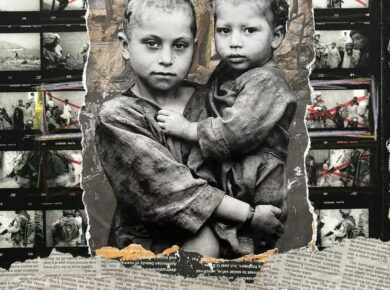Disclaimer: This blog post solely reflects the opinion of the authors and should not be taken to represent the general views of IPPR’s management/ editorial team or those of fellow authors.
The COVID-19 pandemic has upended education systems around the world. Schools closed and students and teachers needed to adapt to the challenges of distance learning. This disruption accentuated the long-term structural failings of education systems that have long impeded children from achieving their full potential. It has also raised questions about the equity and equality in education that highlight the need for policymakers and governments to rethink and way education systems around the world operate.
The United Nations Children’s Fund (UNICEF) has warned of a “catastrophic education emergency’’, as at least 168 million children have missed almost an entire year of education. Social distancing measures and regional travel restrictions prompted a prolonged closure of schools around the world. Many of them remained closed despite openings of restaurants, bars and other social venues, causing a political stir in countries such as the US, that have remained rather silent about providing equal access to education (The Economist, 2020).
Many governments still find it challenging to provide the necessary infrastructure and human capital to get schools going again, and some of them have remained largely closed since March 2020. In middle and low income countries, access to digital technology is scarce, internet connection is poor and children often lack a quiet place to study (OECD, 2020). Earlier this year, the UN Institute for Statistics estimated that during the world-wide school closure, 40% of students did not have access to the internet and could not learn adequately online (Saavedra, 2021). The economic and educational fallouts from this are dire – around 150 million more people could be forced to live in poverty, pressuring more children to leave school. The current ‘’lost generation’’ of students is estimated to lose approximately $10 trillion in earnings due to missed education opportunities.
The pandemic has also raised important questions about the quality and outcomes of current education systems. There were already growing concerns about ‘’learning poverty’’ – the inability to read and understand simple text by the age of 10, particularly in lower and middle income countries. According to the World Bank, learning poverty rates are set to rise to 63% in low and middle income countries, leaving millions of children illiterate and ill-prepared for the job market (2020). However, even in countries where face-to-face or online teaching is in place, this doesn’t necessarily mean that children are learning. International and non-governmental organisations have long argued that education systems globally need to change in order to ensure children are equipped with at least the most basic skills. Worldwide, millions of children – now young adults – lack basic skills such as calculating correct transaction changes when shopping, understanding prescriptions or public transport schedules. If systematic changes are not implemented fast, younger children that are the most severely affected by the schools’ closure are projected to lack these skills to an ever greater degree.
The current circumstances of online education have reiterated a very old problem with education – the inconsistencies of what textbook learning methods are thought to teach and what they actually omit – the development of behavioural, emotional and social skills that are fundamental for students to build a successful and satisfactory career (Jones & Doolittle, 2017). The CEO of the Azim Premji Foundation, a philanthropic education organisation – Anurag Behar – comments that the problem with online learning lies not only in the poor internet connectivity or the lack of technological devices for children, but that it hardly captures the core competencies that students build – the social, emotional and cognitive capacities that help them thrive in our complex world. Virtual lessons, he argues, are currently not effective to provide these skills for children. We know that the issue is not merely about whether teaching is done online or in person – the content and teaching methods require improvement to account for the skills that adults need in the 21st century – something that global education systems have been battling with for decades now. Despite this, the pandemic has also paved the way to thinking about how to integrate technology into the classroom contributing to a more interactive and creative learning experience.
School closures have also interrupted high-stake exams. Governments were forced to make difficult decisions as to whether to conduct important exams, which revived the question of their fairness and value in education systems around the world. High-stake examinations can be challenging to prepare for and can disadvantage students that are particularly dealing badly with pressure, no matter how clever they are. These narrowly formatted exams often times limit the way knowledge, critical thinking and creativity are assessed, leaving useful but more difficult skills to measure out (Wall, 2005). The negative impacts of high-stake exams are concerning. They can potentially lead to a range of mental health problems that can in turn influence the students’ performance at school, as well as their quality of life. Yet abandoning exams can cause a cascade of issues, such as implicitly encouraging students to learn just for the grade or the perspective of unfair assessment if their progress is assessed throughout the year. Objective and adequate assessments also need to change, because without them, disadvantaged students would be unable to learn appropriately.
But how can countries solve the current challenges in education? These are unlikely to be solved by a quick initiative, even if implemented globally. Instead, we need a long-term, holistic and connected approach to education, where all students are supported effectively depending on their needs. Evidence shows that education systems that adapt to the local needs of students and that can adjust teaching and learning amidst changing circumstances are better at ensuring education is equitable (OECD, 2020). Inequalities must be addressed early in childhood to ensure children are ready to learn when they are set to enter school. The difficulty of this task, however, comes from the fact that education inequality is often tied with economic and social inequalities that require holistic preventative policies (García & Weiss, 2017).
However, there is hope. Governments and institutions now have the prerequisite to comprehend what equity in education looks like and why it is an important feature of high-quality schooling (Sahlberg, 2021). We now know that school is not only a place of acquiring knowledge – it is a fundamental part of the social fabric that helps develop the emotional and social capacities of students. Schools also prepare children to approach and respond to challenges healthily and effectively and form healthy relationships with other people, not simply reproduce knowledge memorised from textbooks. Making education systems globally more equitable requires a better understanding of the complexity of skills that students engage with and develop at school.
References:
García, E., & Weiss, E. (2017). Education Inequalities at the School Starting Gate: Gaps, Trends, and Strategies to Address Them. Economic Policy Institute.
Jones, S. M., & Doolittle, E. J. 2017. Social and emotional learning: Introducing the issue. The future of children, 3-11.
OECD 2020. Learning remotely when schools close: How well are students and schools prepared? Insights from PISA. OECD Policy Responses to Coronavirus (Covid-19). Available at: https://www.oecd.org/coronavirus/en/#policy-responses ;
OECD. 2020. The impact of COVID – 19 on student equity and inclusion: supporting vulnerable students during school closures and school reopenings. Available at: https://www.oecd.org/coronavirus/policy-responses/the-impact-of-covid-19-on-student-equity-and-inclusion-supporting-vulnerable-students-during-school-closures-and-school-re-opening s-d593b5c8/#section-d1e3202
Saavedra, J. 2021. A silent and unequal education crisis. And the seeds for its solution. Available at: https://blogs.worldbank.org/education/silent-and-unequal-education-crisis-and-seeds-its-solut ion# [Accessed 30.05.2021]
Sahlberg, P. 2021. Does the pandemic help us make education more equitable?. Educational Research for Policy and Practice, 20(1), 11-18.
The Economist. 2020. Closing schools for covid-19 does lifelong harm and widens inequality. April 30th 2020 edition. Available at: https://www.economist.com/international/2020/04/30/closing-schools-for-covid-19-does-lifel ong-harm-and-widens-inequality [Accessed 30.05.2021]
Wall, D. 2005. The impact of high-stakes examinations on classroom teaching: A case study using insights from testing and innovation theory (Vol. 22). Cambridge University Press.
World Bank. 2020. Realizing the future of learning: From learning poverty to learning for everyone, everywhere. Available at: https://reliefweb.int/report/world/realizing-future-learning-learning-poverty-learning-everyon e-everywhere [Accessed 10.06.2021]
By Remina
Remina Aleksieva is pursuing an MSc in International Public Policy at UCL. She is interested in behavioural science based policy-making, education and environmental policy, and Central and Eastern European politics.







